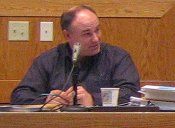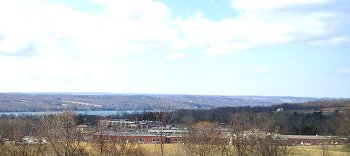- By Dan Veaner
- News
 Print
Print 
Town Supervisor Scott Pinney
But Pinney, Town Councilman Bud Shattuck, and others around town do see a possibility of some of the town getting sewer sooner than that. "There is talk about a standalone plant near Cargill Salt company," Pinney says. "Today's cost for that would be about $3.5 million. We actually have approximately $5 million of bond act money with the DEC right now that was earmarked for the large sewer project. So that would completely cover a sewage plant and some of the trunk line to maybe come up through the B1 and B2 commercial district, or to the Lansing schools, which is in dire need of sewer."
Pinney is absolutely clear that nothing is currently on the table except for the Warren Road project. But town officials are looking back to the roots of the defunct sewer project when the Town wanted to construct a standalone treatment plant and to develop a sewer district organically, according to need. In 1996 the Town estimated such a plant could be built for $2,034,210. In today's dollars that comes to $3,051,000.
Part of the resistance to the larger project came from the insistence of the New York State Department of Environmental Conservation (DEC) that Lansing be part of a shared treatment solution, meaning that it would have to pump effluent from the Town south through the Village of Lansing to the shared Cayuga Heights treatment plant. Environmentalists objected, noting that the current in Lake Cayuga runs counter-clockwise, meaning Lansing would be pumping its waste south, only to have the lake push the treated result northward along 14 miles of Lansing's shoreline.

Town Councilman Bud Shattuck

Lansing Central Schools Campus
With massive budget and financial planning challenges, waste treatment is not high on the school district's list of priorities. "This District does not have an interest in pursuing the development of a sewer due to the financial situation we are in at this time and the functionality of the current system," says Superintendent of Schools Stephen Grimm. "I am content with our current design and implementation of sewage removal and have budgeted appropriately for the maintenance of that system. I see no need at this time to consider a change for the Lansing School District."

Superintendent of Schools Stephen Grimm
These included operating the systems without required SPDES (State Pollutant Discharge Elimination System) permits, without providing records of disinfection or treated water quality, that the 23 to 49 year old systems were likely to provide inadequate treatment, that ditches and streams might be contaminated, and that the systems were being operated without protecting them from damage. Reportedly a ballfield was placed above at least one of the systems.
"The schools have been told this, they know this," Shattuck says. "The hard part may be that they've had such turnover of administration in the last five years that some of that hard information may not be passed along. But if you talk about a tax rise in the school and the budget process, this is a major one."
Shattuck identifies five institutions or areas that need sewer. They include the Gosset Center and the Lansing Residential Center both located just north of 34B on Auburn Road (Rte. 34), the town business district that spans 34B from The Triphammer/Auburn Roads intersection to beyond the East Shore Drive intersection, the Lansing school campus, plus the Ladoga Park neighborhood that frequently finds itself under water when Lake Cayuga rises.
"The cost of going there, pumping it up the hills and going through Cayuga Heights Road to the treatment plant may be exorbitant now," he says. "But there may be enough money in the project, and this is what we're hoping, that they would let us put in a temporary standalone plant. That might be able to treat what we have for a short period of time until more money is available, or there is enough density, or there is enough need to then pay for the rest of the pipe and take everything back to the Cayuga Heights plant."
Shattuck says that if sewer does come to the town, this time it will be different. "It's not a matter of will it happen piecemeal, because it may," he says. "What won't happen is that we're not going back to the residents to say we're going to force this on you at a cost you can't absorb. We may do exactly what we've done with the Warren Road Business Park. Go to the front door of individuals and cookie-cutter them out so there's no cost to them. People would be able to opt-out or opt-in based on that total cost."
| Warren Road Sewer Project 'By The Numbers' | |
 Transonic Systems |
|
Even if sewer doesn't come to Lansing soon, town officials are thinking about how best to plan for it. "One of the things I propose is that developers create their own large private systems," Pinney says. "We have one example that Ron Secord is trying to put in. Originally we were going to go with a transportation corporation that would monitor the sewage system forever and paid for by the people in that development. What I am recommending is that the Town create a waste management district to oversee that. It would still be paid for by just those people in that development. The advantage to that is that the Town would be collecting that money to pay for the yearly maintenance, but we'd also collect money for a replacement system -- whether that be 25, 30 years in the future -- so we'd always have that extra money."
And that replacement system could be a municipal sewer. At that point all a development would have to do is redirect a pipe from its shared septic to the new sewer, if and when it is installed.
As long as there is a sewer project the State bond act money is unlikely to be taken away from Lansing. As Pinney says, one possible use would be to use it to build a standalone plant at no cost to Lansing taxpayers. Shattuck says town officials are also exploring using some of it to pay back the Village for the Klein Road diversion that transports excess effluent from the Cayuga Heights plant to the Town of Ithaca treatment plant, as well as paying back the Town for its expenses in developing the project that was killed.
"Remember the Town fronted all the engineering costs for all of our sewer plans," Shattuck says. "But there's been no money coming back from the Clean Water Bond Act, because, while we had a plan, we didn't have a project. Now we've got a project and we're saying two things. One, we'd like the money to pay for the Klein Road bypass. Two, we'd also like to recoup our engineering costs from the other project. And that's a substantial amount of money. We said, 'If there is any other money from that (bond act money) that might go to (the Warren Road project), we'd be willing to take that, too.'"
Shattuck says DEC has been encouraging, and that Town officials are now following up with contacts in Albany who might be able to make part or all of that happen. Lansing's U.S. Congressman Michael Arcuri has named infrastructure as a priority as recently as two weeks ago at a speech he gave in Lansing to the Tompkins County Chamber of Commerce. And at a recent Association of Towns meeting in New York City U.S. Senator Chuck Schumer said the federal governemt will pay 75% of some infrastructure costs if the State pays 12.5% and the municipality contributes the remaining 12.5%. Shattuck says that the Town has written Schumer requesting a substantial amount of money.
While the town sewer project ultimately went up in flames like the mythological Phoenix, some good may arise from its ashes. The first benefit has been the Warren Road sewer project, which brings service only to people who want it and are willing to pay for it in a logical way that is supported not only by people in the district, but also by all the municipalities involved:
- the Town of Lansing gets to attract new businesses and keep existing ones, and insure expansion of in an area designated for those uses. It brings more good paying jobs to Lansing, and increases the tax base in a way that is beneficial to residents
- the Village of Lansing whose existing sewer will be tapped into
- the Village of Cayuga Heights where the waste will be treated
- the County which sees the sewer as a way to meet two important goals: keep and expand local business and increase affordable housing so that people who work in Tompkins County can afford to live here
- New York State, which uses Empire Zones to encourage business growth and better jobs for New Yorkers
Officials now talk about the water district model, where residents request the service, the Town explores the scope and cost of the limited project, and the residents vote on whether they agree to pay for it. The Warren Road project may serve as a model for future sewer initiatives in Town, using the lessons learned from the larger failed project to bring sewer where it is wanted, paid for only by the people who want it in locations where it makes sense for the town.
Even with a dead municipal project, most officials say sewer will come to Lansing sometime -- it is just a matter of how and when. And where. While sewer in some parts of town will help the town realize its overall planning strategy, Pinney says the Town has other tools it can use to attract business, including streamlining the planning process and just being 'more friendly' to business. So he is cautiously interested in bringing sewer to Lansing, but not in any hurry.
"I see sewer as definitely coming to Lansing at some point in time," Pinney says. "I think sewer promotes some businesses, but other businesses can be promoted without the need for a public sewer system. There are a lot of other strategies I am trying to use to promote the town to businesses. It would be nice to have sewer, but I don't see that as the major tool to attract them."
----
v4i14



